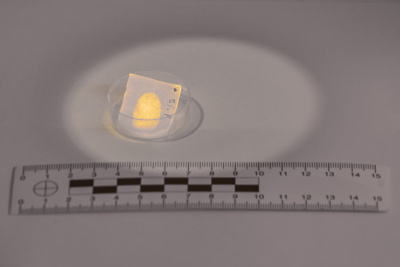Dr Aneta Lewkowicz from Gdańsk University has patented an innovative method for revealing fingerprints on paper used for some government documents and receipts, which has been hard to detect until now. This breakthrough addresses a long-standing challenge for forensic scientists in obtaining reliable fingerprint evidence from such paper.
The new solution developed by Dr Lewkowicz makes it possible to provide clear evidence of someone’s identity or connect them to the scene of a crime. “Although identification is often based on DNA analysis, fingerprints also play a key role in investigations,” she told the Polish state news agency PAP.
The method leads to faster and more precise analysis thanks to clear and lasting prints. It is also safer and more convenient than traditional methods as the solution can be used outside of a laboratory, directly at crime scenes, and is less toxic.

photo by Alan Stocki/UG
Issues with thermal paper
Dr Lewkowicz’s invention has been granted protection by the Polish Patent Office and is expected to significantly impact the acquisition of fingerprint impressions on difficult surfaces. The research on new methods of visualising dactyloscopic traces and less toxic solutions using 1,8-diazafluoren-9-one (DFO) is crucial for the development of forensic science.
Conventional methods for examining fingerprint marks with DFO on absorbent or porous surfaces rely on toxic solvents, which are unsuitable for thermal paper. Revealing dactyloscopic traces on these surfaces is difficult because the solution’s components react with those of the thermal paper.
Dr Lewkowicz’s method differs from those previously used with DFO, as it allows fingerprint marks to be revealed on thermal paper. “The intensive development of communication tools, especially in electronic form, has not ruled out recording, for example, government documents on thermal paper. What is more, in everyday use, we have to deal with receipts that are printed on this particular type of paper”, Dr Lewkowicz explains.
Images on thermal paper, including applied fingerprint impressions, can be highly unstable, particularly during the disclosure process. “The biggest risk is the darkening/reddening of the entire surface of the paper when using solutions to visualise dactyloscopic traces. The procedure I developed avoided this phenomenon and, in addition, significantly reduced the toxicity of the solutions used, which allowed it to go outside the laboratory, i.e. become useful at the scene,” Dr Lewkowicz adds.
The successful visualisation of fingerprint marks was achieved through the characterisation of DFO’s spectroscopic properties. For the first time, the critical role of aggregation processes in forming new spectroscopically active and useful forms during forensic trace disclosure, particularly for fingerprint prints, was highlighted. Time-resolved method studies confirmed that optimising aggregation processes to obtain a stable DFO dimer significantly enhanced the visualisation of dactyloscopic traces on thermal paper. This result represents a significant advance in deriving new fluorescence-active structures without complex organic syntheses that often use toxic co-reagents.
Proud mentors
Dr Wojciech Zalewski, Dean of the Faculty of Law and Administration at the University of Gdańsk, commented on the patent: “This invention of Dr Aneta Lewkowicz, which is important for forensic science, was created within the organisational framework of the Faculty of Law and Administration of the University of Gdańsk. This is a unique situation in which this kind of work is undertaken at the Faculty of Law. We are proud that the strategy of our development built up over the years is bearing such fruit.”
Professor Piotr Bojarski, Director of the Institute of Experimental Physics and head of the Department of Biomaterials and Medical Physics at UG, praised Dr Lewkowicz’s work: “I am delighted that Dr Aneta Lewkowicz, my former doctoral student and currently a member of staff at the Department of Biomaterials and Medical Physics, has successfully applied the knowledge and research tools of our scientific interests to the development of a separate scientific speciality, namely forensic science. Her thoughtful efforts, supported by good interdisciplinary collaboration, led to a national patent. I hope that this success will translate into commercialisation carried out at UG.”
Dr Lewkowicz was supported in preparing the patent description by Dr Krzysztof Czub from UG’s Faculty of Arts and Sciences. The Technology Transfer Office UG coordinated the patent application process with the Polish Patent Office and manages the commercialisation process of inventions at UG.
Sources:
- Polish scientist patents new fingerprint detection method
- Innovative method of visualising dactyloscopic traces protected by patent! | NEWS – Uniwersytet Gdański


